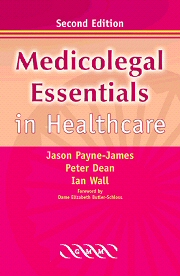Book contents
- Frontmatter
- Contents
- Contributors
- Editors' note for the first edition
- Editors' note for the second edition
- Foreword
- Table of statutes
- Table of cases
- 1 Legal institutions and the legal process
- 2 Human rights and healthcare professionals
- 3 Medical ethics and the forensic physician
- 4 Confidentiality
- 5 Consent to medical treatment
- 6 Professional bodies and discipline
- 7 Complaints in the National Health Service
- 8 The Mental Health Act (England and Wales)
- 9 Death certification and the role of the coroner
- 10 Tissues and organs
- 11 Organ donation
- 12 Living wills
- 13 Euthanasia and end-of-life decision-making
- 14 Abortion and reproductive health
- 15 The Children Act 1989
- 16 Clinical negligence
- 17 Legislation for medicines and product liability
- 18 Clinical trials: ethical, legal and practical considerations
- 19 Medicolegal implications of blood-borne viruses
- 20 Healthcare professionals in court – professional and expert witnesses
- Index
10 - Tissues and organs
Published online by Cambridge University Press: 12 January 2010
- Frontmatter
- Contents
- Contributors
- Editors' note for the first edition
- Editors' note for the second edition
- Foreword
- Table of statutes
- Table of cases
- 1 Legal institutions and the legal process
- 2 Human rights and healthcare professionals
- 3 Medical ethics and the forensic physician
- 4 Confidentiality
- 5 Consent to medical treatment
- 6 Professional bodies and discipline
- 7 Complaints in the National Health Service
- 8 The Mental Health Act (England and Wales)
- 9 Death certification and the role of the coroner
- 10 Tissues and organs
- 11 Organ donation
- 12 Living wills
- 13 Euthanasia and end-of-life decision-making
- 14 Abortion and reproductive health
- 15 The Children Act 1989
- 16 Clinical negligence
- 17 Legislation for medicines and product liability
- 18 Clinical trials: ethical, legal and practical considerations
- 19 Medicolegal implications of blood-borne viruses
- 20 Healthcare professionals in court – professional and expert witnesses
- Index
Summary
INTRODUCTION
Recent advances in medical technology, together with the increased use of human tissues and organs for a wide range of therapeutic treatments and research, have enhanced the potential for commercial exploitation of those tissues and organs. This has resulted in the human body, its tissues and organs being viewed from a different legal perspective. One potential change is the extent to which and in what context a proprietary status can be afforded to human tissues and organs.
The first statutory regulation of the use of the human body for dissection, teaching or research was the Anatomy Act 1832. The legislation was in part a response to the then unregulated common practice of dissecting the bodies of executed felons and paupers and served to act as a deterrent to the infamous practises of Burke and Hare, the body snatchers and grave robbers. The 1832 Act together with the Anatomy Act 1871 was repealed by the Anatomy Act 1984. This 1984 Act, regulates the licensing of premises where anatomy may be carried out and makes lawful the possession of anatomical specimens. It also authorises the examination of a body where an individual has requested that his body be used for anatomical examination.
- Type
- Chapter
- Information
- Medicolegal Essentials in Healthcare , pp. 105 - 116Publisher: Cambridge University PressPrint publication year: 2004

